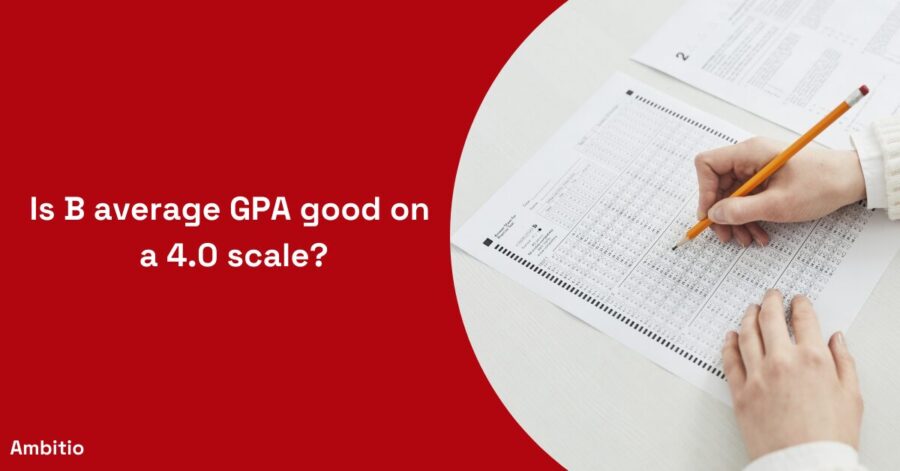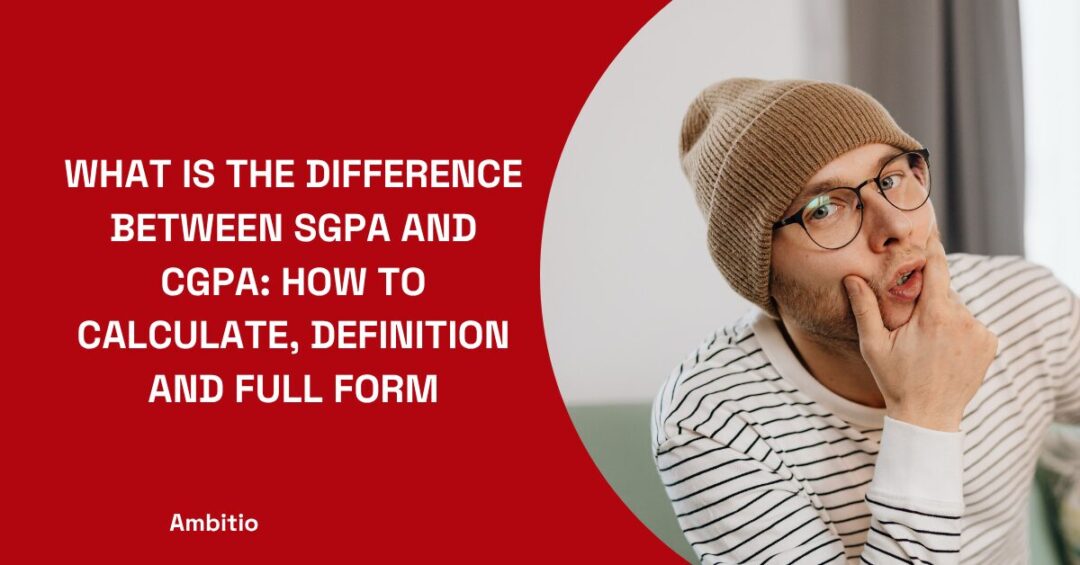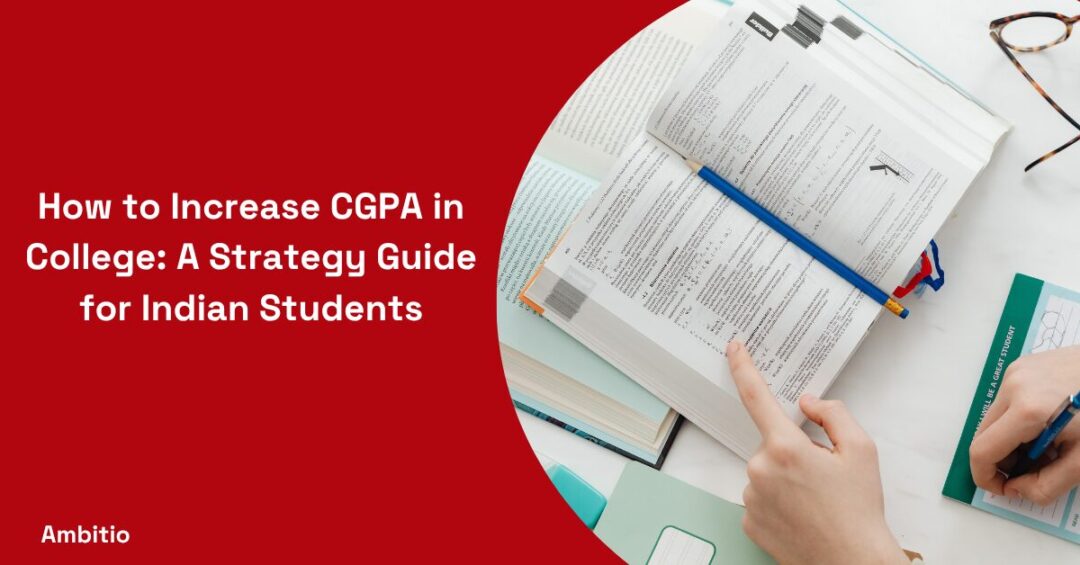9 April 2025
6 minutes read
Is B average GPA good on a 4.0 scale?

Key Takeaways
- A ‘B’ average GPA of 3.0 on the 4.0 scale represents steady academic achievement, suitable for many colleges and job opportunities.
- Utilizing study habits, extra credit, and GPA calculators can help raise your GPA and enhance academic prospects.
- Maintaining a balance between academics, extracurricular activities, and effective time management is crucial for overall success.
“Is a ‘B’ average GPA sufficient?” This question frequently arises for students trying to balance academics with other responsibilities. Understanding the significance of a ‘B’ average GPA is essential for making informed decisions about college admissions, scholarships, and career opportunities. This blog explores what a ‘B’ average GPA represents, how it is calculated, its importance in various contexts, and practical strategies to improve it. Whether you aim to boost your GPA or maintain your current performance, this guide offers valuable insights for achieving academic success.
4.0 GPA scale
Here is a table of common GPA conversions, showing how letter grades and percent grades correspond to the 4.0 GPA scale.
| Letter Grade | Percent Grade | 4.0 GPA Scale |
|---|---|---|
| A+ | 97–100 | 4.0 |
| A | 93–96 | 4.0 |
| A- | 90–92 | 3.7 |
| B+ | 87–89 | 3.3 |
| B | 83–86 | 3.0 |
| B- | 80–82 | 2.7 |
| C+ | 77–79 | 2.3 |
| C | 73–76 | 2.0 |
| C- | 70–72 | 1.7 |
| D+ | 67–69 | 1.3 |
| D | 65–66 | 1.0 |
| F | Below 65 | 0.0 |
What is a B in GPA?
A ‘B’ average GPA generally falls around a 3.0 on the 4.0 GPA scale. It indicates that a student consistently earns ‘B’ grades in their courses. On the 4.0 scale:
- A = 4.0
- B = 3.0
- C = 2.0
- D = 1.0
- F = 0.0
Calculation of a ‘B’ Average GPA
To calculate a ‘B’ average GPA on a 4.0 scale, follow these steps:
- Convert Each Letter Grade to GPA Points: Assign numerical values to each grade (A = 4.0, B = 3.0, C = 2.0, D = 1.0, F = 0.0).
- Sum All GPA Points: Add up the GPA points for all courses.
- Divide by the Total Number of Classes: Divide the total GPA points by the number of classes.
For example, if a student has five B’s, the calculation is:
(3.0+3.0+3.0+3.0+3.0) / 5 = 3.0
This results in a ‘B’ average GPA of 3.0.
Is a ‘B’ Average GPA good?
Yes, a ‘B’ average GPA is generally considered good. It reflects consistent academic performance and a solid understanding of coursework. While it may not be the highest possible GPA, it is often competitive for many colleges and universities, making students eligible for various scholarships and honours programs.
A ‘B’ average GPA can also positively influence job prospects, as employers view it as a sign of reliability and competence. Additionally, maintaining a ‘B’ average indicates good study habits and time management skills, which are essential for success in both academic and professional settings.
Importance of a ‘B’ Average GPA
A ‘B’ average GPA holds significant importance across various aspects of academic and professional life, influencing college admissions, scholarship opportunities, job prospects, and personal academic development.
College Admissions
A ‘B’ average GPA, typically around a 3.0 on the 4.0 GPA scale, is often considered a good GPA for college admissions. While a higher GPA, such as a 4.0, may be preferred by more selective institutions, a 3.0 GPA still demonstrates consistent academic performance and can meet the criteria for many reputable colleges. A high school GPA of 3.0 is seen as a solid foundation for further academic pursuits.
Scholarships and Financial Aid
A good GPA is crucial for securing scholarships and financial aid. Although the most competitive scholarships may require a higher GPA, a 3.0 GPA can still make students eligible for various merit-based awards. Demonstrating a good GPA in high school can significantly ease the financial burden of college education.
Job Market
Employers often consider GPA when evaluating candidates. A 3.0 GPA reflects a reliable academic record and indicates a good understanding of coursework. This can make graduates with a 3.0 GPA attractive to potential employers, especially for entry-level positions.

Academic Progress and Development
Maintaining a ‘B’ average GPA signifies steady academic progress. It indicates that the student understands their coursework well and can balance academic responsibilities with other commitments. Using a GPA calculator to track and raise your GPA can help achieve a higher overall GPA. Participating in weighted GPA courses can also improve your cumulative GPA, especially on a 5.0 scale where more rigorous courses are taken into account. Understanding the grading differences between weighted and unweighted GPAs, and how to calculate your GPA accurately, is essential.
What are the pros and cons of having a ‘B’ average GPA?
Here are the pros and cons of having a ‘B’ average GPA, highlighting its impact on academic and professional opportunities.
| Pros of a ‘B’ Average GPA | Cons of a ‘B’ Average GPA |
|---|---|
| Consistent Performance: Demonstrates steady and reliable academic performance. | Selective Programs: May not meet the GPA requirements for highly selective colleges and programs. |
| College Admissions: Meets the criteria for many reputable colleges and universities. | Competitive Scholarships: Might be ineligible for the most prestigious scholarships that require higher GPAs. |
| Job Market: Reflects a solid understanding of coursework, which can be attractive to employers. | Graduate Studies: Some graduate programs prefer higher GPAs, which can limit options. |
| Balance: Allows for a balance between academics and extracurricular activities or part-time work. | Perception: May be viewed as average compared to peers with higher GPAs. |
| Financial Aid: Qualifies for various merit-based scholarships and financial aid. | High GPA Pressure: Pressure to raise GPA to compete with students having higher grades. |
| Foundation: Provides a solid foundation for future academic pursuits and career opportunities. | Advanced Courses: May struggle in advanced courses that require higher prerequisites. |
How to Improve a ‘B’ Average GPA?
Here are some practical ways to raise a ‘B’ average GPA and enhance your academic performance.
Identify Weak Areas
Focus on subjects where your grades are lower and allocate more study time to these areas. Seek help from teachers, find a tutor, or join study groups to improve understanding and performance. This can help you figure out the areas needing the most attention and improve the grade you receive.
Improve Study Habits
Develop effective study routines, such as regular review sessions, organized notes, and avoiding procrastination. Good study habits can significantly impact your academic performance. A higher GPA represents consistent effort and organization.
Take Advantage of Extra Credit
Participate in extra credit assignments whenever possible. Extra credit can provide a buffer and help raise your overall GPA, particularly if your GPA is around 3.0. Many colleges consider extra credit in their admissions process.

Retake Courses
If your school allows, consider retaking classes where you received lower grades. Improving your grades in these courses can positively impact your GPA. For example, raising a C average to a B average can make a significant difference.
Utilize Resources
Use resources like GPA calculators to track your progress and set realistic goals. A GPA calculator can also help you understand how future grades will affect your GPA. Stay organized with planners and reminders for assignments and exams. Schools like Google Classroom can help you stay on top of your coursework.
Practical Steps to Enhance GPA
To achieve a GPA of 3.0 or higher, follow these strategies. For a higher GPA, aim for consistent performance in all courses. Many graduate schools require a particularly high GPA, often above a 3.6 GPA. Knowing your school’s standard 4.0 scale and how grades are divided by the total credits can help one another in maintaining good academic standing.
Eligible for financial aid often requires maintaining a good GPA, and graduate schools may require higher GPAs for admission. Whatever the case, focusing on improving your GPA will benefit your academic and professional future.
Conclusion
A ‘B’ average GPA, typically a GPA of 3.0 on the 4.0 GPA scale, is considered good and opens many doors for students in terms of college admissions, scholarships, and job opportunities. This GPA represents consistent academic performance in the 83–86 percent range. Many colleges and graduate schools in the U.S. may use different scales to evaluate applicants based on their coursework and extracurricular activities.
By understanding the significance of a ‘B’ average GPA and utilizing available resources, such as guidance counsellors, students can make informed decisions about their academic and professional futures and focus on effective study habits and a balanced approach.
Realize your dream university admission with Ambitio Elite. Harness the potential of personalized guidance, AI Copilot, and expert mentorship. Your academic journey begins here! Get Started with Ambitio Elite
FAQs
How do different grading scales affect a ‘B’ average GPA?
Different schools and countries may use varied grading scales, but a ‘B’ average GPA typically translates to a 3.0 on the standard 4.0 scale, indicating consistent performance across different contexts.
Can a ‘B’ average GPA qualify for financial aid?
Yes, a ‘B’ average GPA can qualify for various forms of financial aid, though maintaining eligibility often requires meeting specific academic performance criteria.
Is a ‘B’ average GPA good for graduate school?
Many graduate schools prefer higher GPAs, but a ‘B’ average GPA may still be acceptable depending on the program and additional criteria such as work experience and test scores.
How does a ‘B’ average GPA affect job prospects?
A ‘B’ average GPA can positively influence job prospects as it demonstrates reliable academic performance and competence, especially for entry-level positions.
What scholarships are available for students with a ‘B’ average GPA?
There are various merit-based scholarships available for students with a ‘B’ average GPA, though the most competitive scholarships often require higher GPAs.
Can I get into college with a ‘B’ average GPA?
Many colleges accept students with a ‘B’ average GPA. While more selective schools might prefer higher GPAs, a 3.0 GPA can still meet the criteria for many reputable institutions.

You can study at top universities worldwide!
Get expert tips and tricks to get into top universities with a free expert session.
Book Your Free 30-Minute Session Now! Book a call now




























